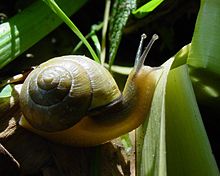
Reproduction
It was found
that for Millerelix simpsoni there is little information about the specific
mechanisms on its reproduction. However, this species is
a terrestrial, pulmonate snail and therefore one can get
a general idea of its reproduction based on the how
pulmonate snails reproduce. Moreover, reproduction for
pulmonates occur only when environmental conditions are
favorable (Leonard, 1959). Unlike other gastropods seen
pulmonates are monoecious, meaning that
Millerelix
simpsoni has both female and male sex organs (Thorp
and Covich, 2010; Hickman et al. 2012). The male sex
organs that are present include: duetus deferens and the
penis (Leonard, 1959). While the female sex organs are
the albumen gland, oviduct or uterus, vagina and
spermatheca (Leonard, 1959). An ovotestis and
hermaphroditic duct are also present in the snail,
independent of its sex (Leonard, 1959).
With hermaphrodites, some organisms
self-fertilize their own eggs (Thorp and Covich, 2010).
However, according to Bryon Leonard this process of
self-fertilization is not common in these terrestrial
snails (1959).

Learn more about the
Anatomy of Snails
Continuing onto
the mechanisms of the reproductive system, eggs can be
released from the snail through the hermaphroditic duct
(Thorp and Covich, 2010). At this point, the still
unfertilized egg will receive nutrients and protein from
the albumen gland (Thorp and Covich, 2010). Next, the
sperm will fertilize the egg, which is located between
the hermaphroditic duct and oviduct (Thorp and Covich,
2010). According to Byron Leonard, a unique feature
about the snail’s reproductive system is that several
snails are unable to fertilize eggs using their own
sperm (1959). Essentially, they have built up a
resistance to their genetically inherited sperm
(Leonard, 1959). Based on the facts that most pulmonates
do not practice or in some cases not capable of
self-fertilization, one can assume that
Millerelix
simpsoni also does not self-fertilize.
This being stated, other snail then fertilizes
the eggs. These eggs will be secreted by the oviduct and
then laid to various types of grasses or rocks (Thorp
and Covich, 2010). Another feature about pulmonates are
that they go through a direct lifecycle (Hickman et al.
2012). In other words, the snail does not have any larva
stages. It goes from an egg to a juvenile snail and
finally to an adult snail. With direct lifecycles, the
organism’s morphology does not change however, the
organism will likely increase in size (Hickman et al.
2012).
Return to Homepage
